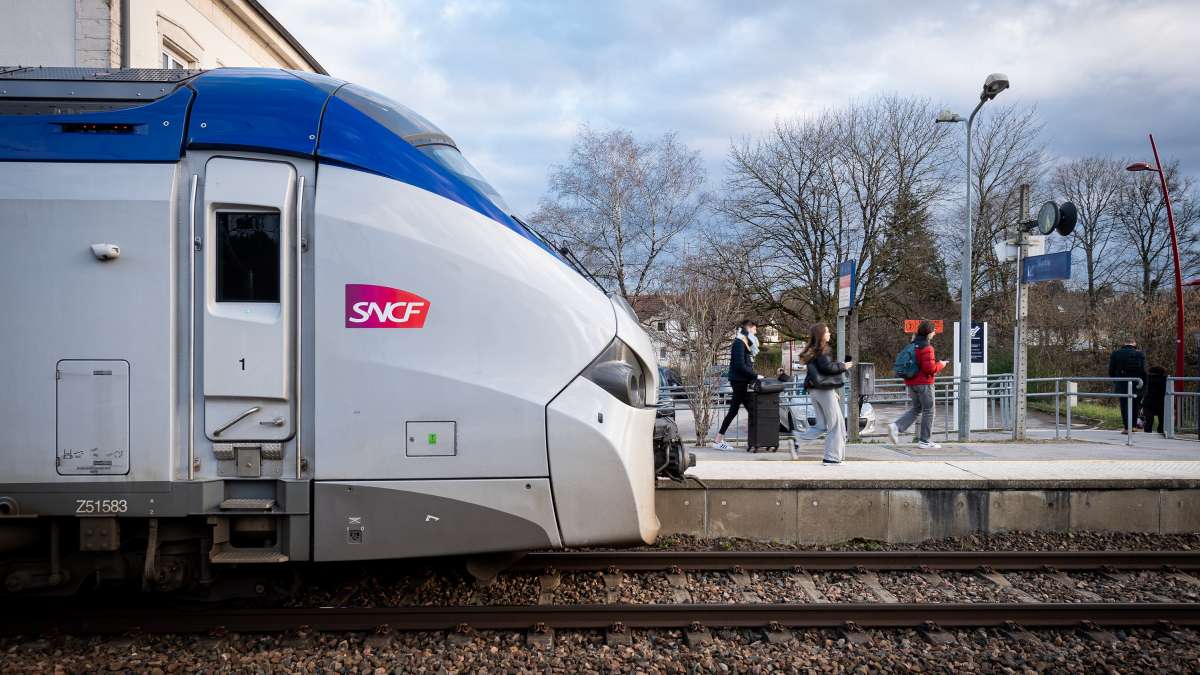

News from the ESPRIM: Disruptions and Resilience of Mobility systems
Learn about the team, their challenges, its members, and the latest news...... by consulting his page
This Cerema volume describes innovations and combinations of qualitative and quantitative methods, recourse to new data sources and new tools, to gain knowledge about geographical mobilities on a daily scale.
Focus on the hybrid methods for analysing mobility
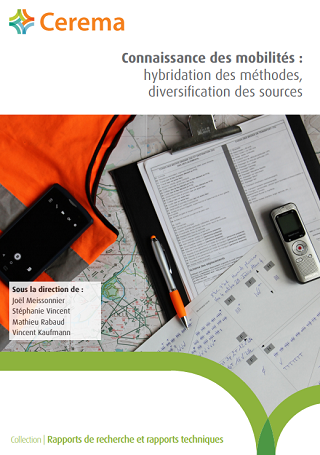
Methods to investigate and analyse mobility behaviours are multiplying, and becoming more sophisticated and complex, in order to adapt to significant changes in mobility practices.
This document is based on the work conducted for nearly twenty years by a mobilities working group from the AISLF (International association of French-speaking sociologists), looking at spatial mobilities and social functioning. A call for articles was issued in 2016 to receive innovative methodologies for analysing daily geographical mobility.
Given the important role that mobility has come to play in our lives, many research projects have examined this subject. The idea of issuing a call for articles with a methodological bent was based on an observation made by the coordinators of this volume (Joël Meissonnier, Stéphanie Vincent, Mathieu Rabaud and Vincent Kaufmann); namely that new methodological systems have recently been tried out and some of the work has proven to be truly creative from this point of view.
Over the years, studies of the different facets of mobility as both an individual and collective practice have developed. The methodological protocols have become more complex, making use of different types of methods, which we describe as hybrid. The complementarity between qualitative and quantitative approaches is particularly vital as there is a strong temptation to make use of big data (ticketing data, social networks, data originating from vehicles, etc.).
New protocols are attempting to foster communication between qualitative and quantitative methods, but also delve into new sources of data. They use completely new tools or undertake innovative combinations to renew knowledge in the field of mobilities.
This collective volume therefore brings together nine original scientific contributions comprising stimulating methodological proposals, to enhance our understanding of mobilities.
Bringing together qualitative and quantitative methods
The nine contributions we present explore various forms of methodological innovation and hybridisation in order to gain a more precise, comprehensive and relevant view of daily mobilities.
Analysing mobilities of young people based on data from Twitter, a web questionnaire and in-depth interviews
Jean-François Lucas, Emmanuel Ravalet, Guillaume Drevon
This contribution presents a mixed methodology designed to investigate mobility practices and representations among teenagers. It combines different methods in order to compensate for the limits of one by the advantages of the others.
The methodology puts its faith in hybridisation, combining an initial exploratory qualitative analysis of millions of pieces of data from Twitter, a second analysis produced from a quantitative survey taken from a survey posted on Facebook, and a third analysis performed thanks to a second qualitative analysis relying on semi-directive interviews.
This chapter looks in particular at the different types of combinations conducted and indicates the lessons learned from this attempt at hybridisation from the point of view of method cross-referencing and from the point of view of results.
Pairing of an ethnographic survey and digital traces: application to daily mobilities in a district of Bangkok
Alexandre Cebeillac, Brenda Le Bigot
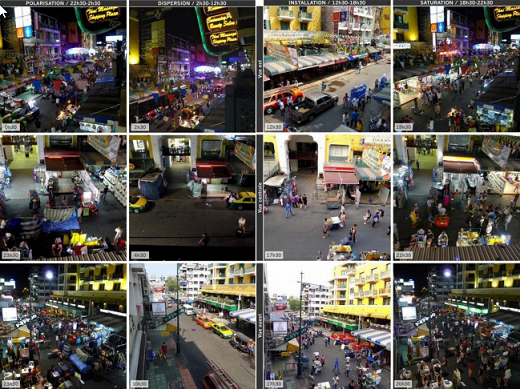
A hybrid methodological approach can be very beneficial in order to understand the co-presences and interactions within a single space, which are born from mobilities and produce places. By comparing data of different types, and multiple angles of approach it will be possible to gain a clearer perception of the diversity of movements and experiences in the space.
This contribution proposes to test the coupling of two approaches: an ethnographic survey and an analysis of two years of digital traces (Twitter) to understand the daily mobilities that contribute to the production of the central Khao San Road district in Bangkok.
This approach is based on a conception of place, here Khao San Road, as being “relational”. Far from being a fixed portion of space, the district is considered here as a time space continually recomposed by the social relations that take place within it and that refer to many different spatio-temporal scales.
The study also presents the results obtained from two directions of questioning:
-
the daily temporalities of the district;
-
the spatial footprint on the scale of Bangkok of the mobilities of the different groups present at Khao San Road, and the role of this district within their urban practices.
Mixed speech analysis methods to understand the mobility of non-motorised households
Dominic Villeneuve
The research presented in this chapter explores the mobilities and perception of a region by individuals originating from non-motorised households on the scale of daily life, as well as social exclusion and the links with public policies implemented in different regions. It compares the regions of Quebec in Canada and Strasbourg in France, because their situations are very different, and public mobility policies also differ considerably, and are even divergent.
In order to understand the phenomena in question, the study adopts a comparative approach based on mixed methods, taking account of the collected data from the qualitative and quantitative point of view, in order to compare these two urban regions.
This is a hybrid method, since it combines two different analyses of the same data: more traditional computer-assisted speech analysis and lexicometric analysis.
Spatial variability of modal behaviours: what are the advantages of GWR (Geographically Weighted Regression) to construct targeted public actions?
Christophe Enaux, Philippe Gerber, Marius Thériault, Samuel Carpentier-Postel
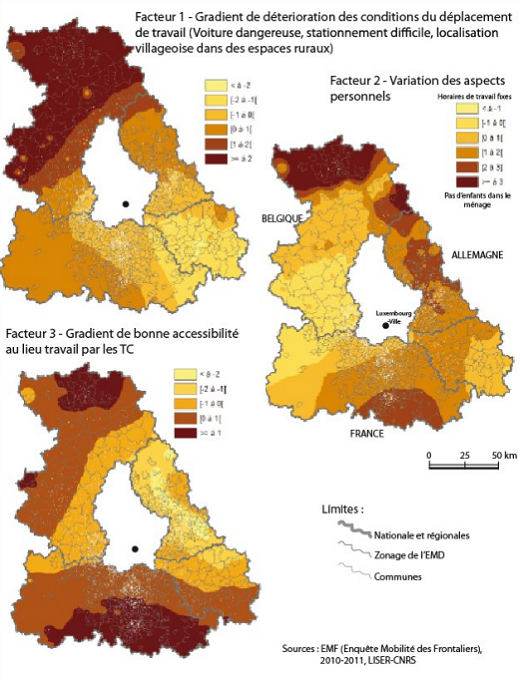
Among contemporary concerns, the concept of sustainable mobility aims to limit negative externalities such as pollution and congestion. It derives from the conjunction of three fundamental dimensions: moving more effectively, moving differently, moving less.
Apart from the fact that a daily mobility system that for a very long time has favoured one mode, i.e. the car, cannot be de-constructed overnight, modal behaviour has its roots in a complex system of factors that create true habits.
However there is no consensus as to the role and intensity of these different individual and contextual factors affecting modal behaviour.
The possibility of spatial variability of relations from one place to another between the factors contributing to the behaviour is an innovative approach which has been hardly examined at all in the area of transport, and this is the approach adopted in this study.
The GWR method undeniably has advantages for analysing and revealing the spatially variable influence of a whole series of factors on a dependent variable.
It is an innovative approach making it possible to define mobility policies in detail on a local scale. It identifies specific factors (infrastructures linked to the transport system, spatial organisation, social characteristics and behavioural practices of residents, etc.) which could be given priority in order to produce a more sustainable kind of mobility. However the accuracy of the results depends on the quality of the information.
The aim in particular is to see how a method for analysing mobility surveys can pinpoint new insights making it possible to identify certain operational levers to facilitate modal transfer.
Survey methods on the move: mobile professionals - A comparison of data from quantitative and qualitative surveys
Reinhard Gressel, Fabrice Hasiak, Samuel James, Patrick Palmier
Mobile professionals are labour force participants who to do their job must travel independently outside their companies or organisations to which they belong to visit a “customer” at a specific site where their skills and intervention are required.
Although research has been conducted on this subject, mobility of mobile professionals remains broadly rather obscure even though there is a great deal at stake, particularly due to the environmental burden that it engenders. It is quite ordinary, everyday, predominantly local and involves a large number of ordinary professions.
To remedy this deficiency, this study adopts a dual approach that is both quantitative and qualitative
Perceptions of environments by pedestrians: qualitative and quantitative use of photographic media to record and compare spaces that are crossed
Marie-Axelle Granié, Marie-Soleil Cloutier, Juan Torres
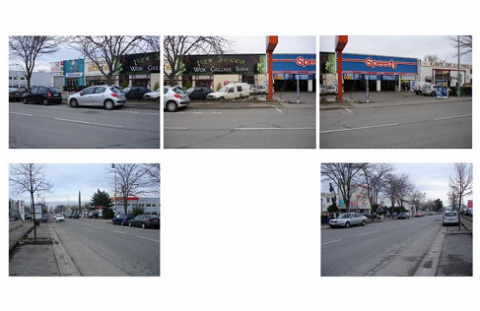
Over the last few decades, many research projects have explored perceptions of road environments by pedestrians. This work enables us to better understand the general determinants of pedestrian mobility. However, it does not give us very much information to understand the behaviour of pedestrians in specific situations, such as when they cross a road.
It does not enlighten us either about pedestrians’ expectations concerning their anticipation of the behaviour of other road users. Our knowledge about how a pedestrian perceives their environment and the influence this has on the way they manage their movements and cross roads (particularly the decision-making process) is limited.
This study proposes a method for collecting pedestrians’ perceptions which is part and parcel of traditional visual research methods used in social sciences. It uses photo-elicitation; a method consisting in triggering reactions, which are usually verbal, from participants who are shown visual stimuli (photos, drawings, films), and using these reactions as research data. The photo-elicitation method is then combined with quantitative approaches.
How should the different dimensions of urban walking be re-articulated?
Edna Hernández-González, Florian Guérin, Jérôme Monnet
For reasons to do with the environment, health and attractiveness, amongst others, today’s urban stakeholders are giving greater importance to walking. However, although they have expertise in providing locations for leisure walking (green areas, pedestrian zones in shopping districts or heritage areas, etc.), they are not so familiar with measures to facilitate walking as a form of mobility, and how to integrate them into the transport system.
To restore the unity of walking, this project presents a hybrid methodology to study the functioning of a section of Rue du Faubourg du Temple, a street in Paris chosen in agreement with the municipal departments, because of the intensity of use, and the dysfunctions of recent measures taken to encourage pedestrian mobility. This contribution shows how the methods have been articulated to reflect the complexity and the temporal aspects of urban walking.
Mobilities and dynamic processes in public spaces: a methodology combining surveys using questionnaires and observations
William Berthomière, Marie Chabrol, Maria Mercedes Di Virgilio, Françoise Dureau, Jean-Pierre Lévy, Thierry Lulle
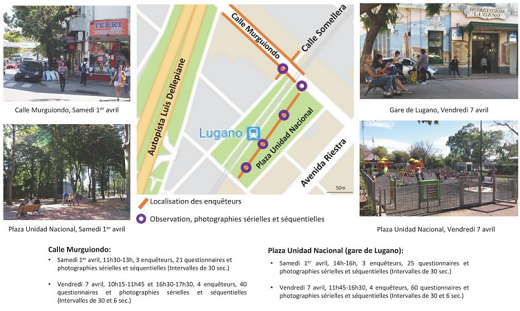
The study of daily mobilities, taken to be "all of a population’s mobility practices in its usual context" is part and parcel of increasingly diverse investigations, leading to many methodological advances. In addition to producing knowledge about mobility practices, the aim of these data collection activities can be to analyse and understand the dynamic processes occurring in urban areas and various locations within them.
This contribution presents a system for data collection in public spaces combining a survey using short questionnaires with on site observations. More recently, in research concerning socio-spatial reconstitutions under way since the 1990s in historic suburbs of Latin American metropolises, the approach was enriched with a second component: the constitution of a photography and video corpus.
A relational approach to daily mobilities
Thierry Ramadier
This contribution seeks to define the methodological elements of a relational approach to geographical movements, which are also referred to as geographical mobility. This approach emphasizes the socio-morphological aspects of the geographical space.
It presents the methodology to describe and understand daily mobilities, based on the following assumption: although restriction of our geographical movements is tantamount to a veritable infringement of our freedom in the broadest and also the narrowest sense, nonetheless our daily journeys are not the sign or the vector of any kind of freedom that could be defined on an individual level.
Indeed, mobilities are bound within a bundle of valuated (i.e. positive) meanings, and are more the sign and vector of freedom that would be defined on a collective level, and would be developed taking into account our social relations.
Since the daily mobilities are recorded based on the relation between the geographical situation and the socio-cognitive dispositions of the person, some of the tools developed will be used for the survey, while others will only be used for analysis. Accordingly, recording of the usual characteristics of daily mobilities (place of departure and arrival, time, mode, associated activity, etc.) and indicators on the manner in which the journey takes place are tools that are used to question the sample of survey respondents. On the other hand, the geographical situation and its relation with how people manage space are completely opaque for the survey, since these tools are only used for the analysis.
Cerema contacts : Joël Meissonnier, Mathieu Rabaud

News from the ESPRIM: Disruptions and Resilience of Mobility systems
Learn about the team, their challenges, its members, and the latest news...... by consulting his page

